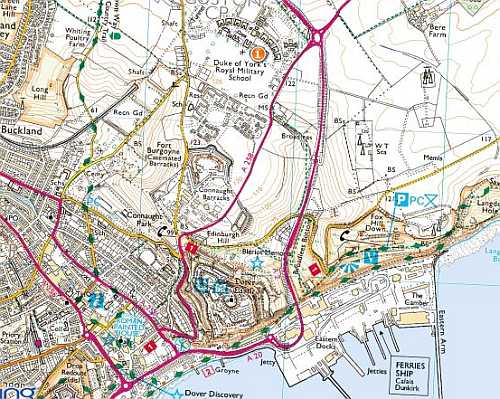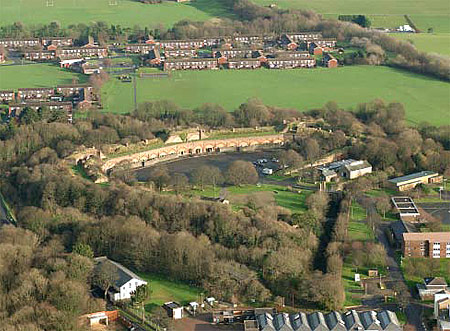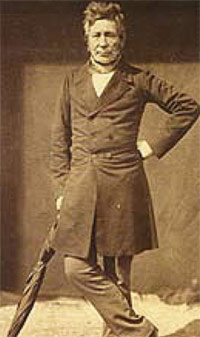CASTLE HILL FORT
FORT BURGOYNE, DOVER – 2011
Ian Lawrance
Having been in the Duke of York’s Royal Military School from 1951-1956 I was recently surprised to find that there had been a 19th Century Commission Fort situated between the school’s Southern (or playing fields) perimeter fence and Connaught Barracks.
With its closeness to the Continent Dover has since the 12th century been of strategic significance to the Southern defence of England. Commencing with the medieval and historic Dover Castle the port town has always had a considerable military presence. In the 16th century Archcliffe Fort, on the sea front below the Western Heights and Mote’s Bulwark were built as part of the coastal defences.
During the 18th and 19th century the threat of invasion by France was considerable, coupled with the advancement in artillery development. Dover became a garrison town.
The castle offered limited protection and defensive fortifications were authorised to be built by Parliament, particularly on the Western Heights, which were subsequently constructed between the years 1779-1810.
General location of Fort Burgoyne in relation to the Duke of York’s School

With acknowledgement ©Crown Copyright
These included the Citadel, North Centre Bastion and Drop Redoubt, all connected to each other by four miles of protective deep dry ditches. In 1860 access was restricted to two gates, Archcliffe Gate and the North Lines Entrance. Further defences included St Martin’s, North Lines Batteries, Grand Shaft and South Front Barracks, all in all providing accommodation for some 4,000 soldiers.
In August of 1859 Viscount Palmerston, the prime minister, persuaded Parliament to improve the defences of Portsmouth, Plymouth, Pembroke, Portland, the Thames Medway, Dover and Cork at a cost of three million pounds. Included in this sum was the construction of a new work on the high ground to the North of Dover Castle, giving protection to the castle from land attack and to provide covering fire across the North front of the Western Heights and Dover harbour by both guns and musketry.

In 1860 the Secretary of State for War approved the construction of a polygonal designed fort comprising various buildings, defence structures, tunnels and excavated outworks, all arranged around a central parade ground. Distinctive to this fort were its East and West Wing batteries. The fortification was to be known as Castle Hill Fort and work began in 1862.
With permission www.dover.gov.uk
Aerial view of Fort Burgoyne
The Outworks (meaning part of a work separated from the main body, but within the glacis i.e. a ravelin or redoubt in front of a salient) which surround the fort and which connect to the Wing Batteries consists of a dry ditch twelve metres deep and twelve metres wide at the bottom, cut into the chalk sub-strata. Where the chalk face is weak it is revetted with concrete. Thus, an attacker would have no protection from the guns covering him. This use of concrete in Outworks is another exceptional feature of Fort Burgoyne.
The fort, designed by Captain Edmund Du Cane RE of the Royal Engineers Construction, was re-named Fort Burgoyne in late 1862 in honour of General Sir John Burgoyne, Inspector of General Fortifications. Our Captain was obviously something of a politician! The East and West Wing Batteries were completed in 1869.
The fort had 35 guns on the fighting platform of the rampart behind the parapet. Another twenty four were in the Caponiers and gun room; five on the East Battery and another four on the West Battery. With the advancement and improvement in weaponry, these armaments were reduced in 1886. Towards the end of the nineteenth century the large guns were replaced by fewer and smaller weapons with more emphasis on machine guns and moveable armament. This was combined with the erection of gun platforms for the use of field guns and marked the end of the fort as a permanent defensive structure, becoming more a defensive barracks in 1897.
Towards the end of the nineteenth century Dover harbour had become a thriving commercial port which, together with the introduction of the modern railway, led to added prosperity for the town.

Designer of the Fort, Captain du Cane RE, also designed Wormwood Scrubs
With permission www.dover.gov.uk

In 1912 a new barracks, Connaught Barracks, was opened on the east side of the town on land just to the South of Fort Burgoyne, connected to the fort by a fixed bridge which spanned the fort’s Outworks. This bridge had originally been a drawbridge but this had been removed and replaced by a fixed structure.
During the Great War Dover became a town of considerable military importance. Its barrack accommodation allowed for vast numbers of men and supplies to be assembled for shipment across the channel to France and Belgium. It was also home to the Royal Navy Dover Patrol, a collection of warships and vessels protecting the Straits of Dover. In 1916 two anti-aircraft gun emplacements were constructed on the forts Casement roof.
At the start of the Second World War, little thought was initially given to the protection of Dover. This drastically changed with the fall of France and the subsequent evacuation of the British and French armies from Dunkirk. Almost overnight, arsenals and stores around the United Kingdom were stripped of every piece of available ordnance and this was rushed to the South coast. Dover was once again designated a garrison town and a fortified naval port.
General Sir John Fox Burgoyne of the Royal Engineers
An eight 25-pounder gun battery was constructed on the Chemin des Rondes around the perimeter and again, Fort Burgoyne is unique as this is the only surviving eight gun site in the United Kingdom. A series of wire hoops in the ground probably served as restraint points for Barrage Balloons. Connaught Barracks also had a historical number of anti-tank buoys positioned alongside its roads and a Flame Fougasse system situated at the junction of the Dover to Deal road and Guston Village lane. The East and West Batteries were reinforced with Spigot Mortar positions and two-rifleman trenches. Historic graffiti of Mickey Mouse and Pluto plus others is apparent on these defensive structures and should be preserved as of historic wartime interest.
The original Connaught Barracks was demolished in 1962 and rebuilt at a reported cost of £750,000. Eventually it was abandoned by the Ministry of Defence in 2006, the last unit serving there being the 1st Battalion the Parachute Regiment.
The barracks site is up for redevelopment for housing as long as certain planning and ecological conditions laid down by Dover Council are met. These include that ‘a comprehensive record is made to all buildings prior to their demolition.’ Also, that ‘the design incorporates foreground buildings and creates vistas and focal points using retained trees and having particular regard to relationships with Fort Burgoyne, Dover Castle and the Western Heights and impact, on the adjacent landscape especially the Kent Downs Area of Outstanding Natural Beauty.’
Fort Burgoyne is a classic British Royal Commission Polygonal Fortification typical of many such forts built during the Victorian era. Arguably, it is the largest fort of its type built in Kent and the only one with two intact Wing Batteries accessed by ditched Outworks. The fort, for long hidden from public view within the barrack area and currently unused, is on the English Heritage Buildings at Risk Register and is a Scheduled Ancient monument. Since the nineteen forties the fort has been used as a stores and non-residential barrack facility by the occupants of Connaught Barracks and is in a derelict state. A suitable and sustainable long term future for the fort is being sought.
Two other forts, namely Fort Nelson in Portsmouth and the Royal Crown Hill Fort in Plymouth have successfully been preserved and brought back into useful public service. Fort Nelson, owned by Hampshire Council, is leased to the Royal Armouries for the exhibition of military artillery and as a site for military re-enactments and displays. Royal Crown Hill Fort in Plymouth was purchased by the Landmark Trust in 1987, restored and opened to the General public in 1990. It has a mixed use, including commercial small business, storage, a site for vintage car events, limited open days, school and other historical group visits and as a site for weddings. Its previous Officers Quarters are now rented out as holiday accommodation.


